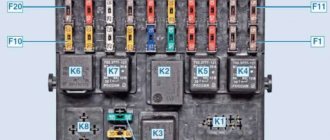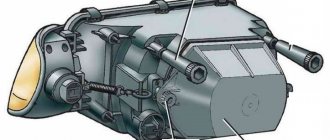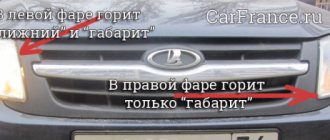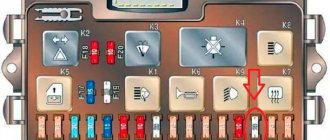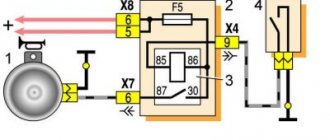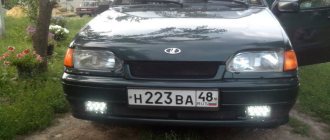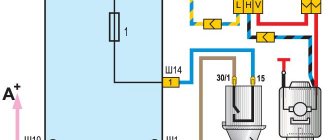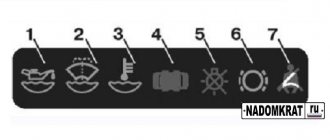The low beam of the VAZ 2112 does not light up
- Registration
- Entrance
- To the beginning of the forum
- Forum Rules
- Old design
- FAQ
- Search
- Users
Swap the high and low relays.
Today the situation is similar. I don't understand. First, the left low beam lamp died. checked with a tester - not working. I changed it from the right one - the right one in the place of the left one also does not work, I put the lamps back as they were, both stopped working. After that the dimensions immediately stopped working. I understood from the dimensions that the previous one was dead. I changed it and the dimensions worked. the neighbor has completely disappeared. Long range and PTF work fine. There are no spare pre-leads for the required amperage. The relay seems to click. if you checked it correctly)) before that, I measured the voltage on the headlight chip with a tester, but some bad person switched the red wire to 10A on the tester, of course, the tester did not show anything in the “20” voltage mode. which could have caused the tester mode to be in “10A” mode.
VAZ 2112 low beam headlight does not light up
Greetings, masters! Such a problem: the low beam on the VAZ 2110 does not work! Moreover, it is the near one, but the distant one works. I changed the glass and cleaned the headlights, after which the low beam disappeared!! What could have happened and where to look for him now?! Thank you in advance!
Check the fuse first, it could have blown, then check the relay, is it working or not? Does it click? If everything is normal, measure the voltage on the lamps, and then on the fuse itself! Disassemble the block and inspect everything carefully!
I measured the voltage - zero everywhere. I opened the unit, looked superficially, everything seemed to be normal. Where else to dig, where could the low beam have disappeared??
Check the button. In general, it’s not clear. Did you measure the voltage on the lamps, on the fuse, and did the plus come into the block or not?
Low beam not on? This is a fairly common phenomenon on Lada family cars. There can be many reasons for this, as practice shows, and, as my personal experience says, almost all of them are banal and extremely understandable. I will give a few of them, for sure there is nothing serious in your case, you just need to carefully examine everything again.
I also encountered a similar problem when taking headlights apart for polishing. After some time, the low beam disappeared. I don’t know if this has anything to do with their disassembly or not, but the breakdown was fixed fairly quickly.
The lamps could burn out
Halogen lamps are designed in such a way that different filaments are responsible for the low and high beam. That is why drivers are often faced with a situation where there is high beam, but no low beam. The reason may be precisely the lamps that simply burned out.
How to fix the problem? Nothing complicated, no electrical knowledge required. It is enough to open the hood, pull out the contact group, release the clamps, unscrew the old lamp and install a new one in its place.
Other reasons
Lamps are one of the simple and common reasons for the lack of low beam, but they are far from the only one. I strongly recommend that you also check:
- Headlight fuse - blown or not
- Relay - functioning normally or broken
- Button - works properly, or is stuck
- Wiring - are they oxidized, do they allow current to pass through?
Carefully inspect the entire wire, as well as the terminals for connection to the fuse and relay. If necessary, tighten the nuts and clean the contacts. Also, don’t forget about the button, the wire going to it could have fallen off, or simply come off. In domestic cars, it is the button that needs to be checked first - this is one of the weakest points!
When the headlights on any car simply do not work, this is an ordinary case. The cause could be the light switch, fuses, or other common things. The “ten” has a feature, without knowing which you can check everything you can to the point of stupor, but still not find the fault.
Usually everything looks like this: the headlights or side lights of the “ten” do not work, and randomly, for example, the left side headlight does not work, the side lights on the right front and left rear do not work. The fuses are intact and many owners of the “ten” are very surprised. It's no wonder if you don't know one secret.
This secret is located in the fuse box, which on the VAZ-2110 even looks like a black box. Once you open it, you will see fuses and relays, with one relay being larger than all the others. It is called a lamp monitoring relay and ensures that the lamps in the headlights and side lights are intact. When a light bulb burns out in the indicated places, the relay sends a signal to the display unit of the on-board control system, the pictogram lights up in it and a typical decimal “ding-ding” is heard.
Inside this relay there are four spirals - these are resistors and the point is that one of these spirals can burn out. This happens, of course, for a reason, but as a result of a short circuit, but the main “trick” is that the resistors of this relay burn out faster than the fuses in the block! That is, absolutely all the fuses are intact, everything is great, but some light bulbs do not work. What is also confusing is that the failure occurs according to an illogical pattern (which may not work, described above), which is why many people think about a bad “ground” in some connection.
If you know about this feature of the “tens”, then identifying a burnt-out relay is a couple of trifles. It can be freely pulled out of the block and disassembled. To disassemble this relay, you need to carefully pry off the bottom cover with a screwdriver, from which the contacts come out, and remove it. Resistors will be visible immediately, and a burnt one even more so. Then it is better, of course, to buy a new relay, but it is not a fact that it will not burn out the first time you turn on the headlights - most likely there is a short circuit in the network.
Why VAZ-2112 headlights do not work and repairs
On VAZ-2112 model vehicles, left and right headlights are mounted on the front. This design combines both low and high beam. Manufacturers can be Bosch or Avtosvet, respectively, and the products have minor differences. However, the mounts are always located in the same places, which allows you to easily install headlights made in different factories. The light bulbs used are also absolutely identical. Their characteristic feature is the presence of only one filament coil.
What to do if for some reason the headlights installed on the VAZ-2112 do not work? We'll talk about this further.
Headlight wires VAZ 2108, 2109, 21099
The headlights of VAZ 2108, 21081, 21083, 2109, 21091, 21093, 21099 cars are equipped with low/high beam headlight lamps, a marker lamp, and a turn indicator lamp.
Headlight wires VAZ 2108, 2109, 21099
Each of the headlight units is connected to two blocks (chips) of wires for these lamps. One main one is for the headlight itself, the other is additional for the turn signal section.
Pinout of headlight wires for VAZ 2108, 2109, 21099 cars and their modifications
Main wiring block
The shaped block (attached to the headlight in only one position) combines four wires. The pinout of the wires is as follows.
Right headlight
1 - Gray wire (+ for low beam). It comes from terminal “6” of block Ш5 (Х5) of the mounting block. Inside the headlight, a white wire continues in the lamp block.
2 - Green wire (+ for high beam). It comes from terminal “1” of block Ш5 (Х5) of the mounting block. Inside the headlight, the yellow wire continues in the lamp block.
3 - Black wire (common negative to the headlight). Mounts to the body next to the headlight. On cars up to 1998. The black wire to ground of the engine cooling system radiator fan switch sensor is connected to them. Inside the headlight, a black wire continues to the lamp socket.
4 - Yellow wire (+ to the side light bulb). Goes to pin “8” of block Ш6 (Х6). Inside the headlight, the blue wire continues to the side light lamp.
Left headlight
1 - Black-gray wire (+ for low beam). It comes from terminal “3” of block Ш5 (Х5) of the mounting block. Inside the headlight, a white wire continues in the lamp block.
2 - Black-green wire (+ for high beam). It comes from terminal “2” of block Ш5 (Х5) of the mounting block. Inside the headlight, the yellow wire continues in the lamp block.
3 - Black wire (common negative to the headlight). It is connected to the negative wire of the turn signal and mounted on the body next to the headlight.
4 - Yellow-black wire (+ to the parking light lamp). It comes from terminal “10” of block Ш6 (Х6). Inside the headlight, the blue wire continues to the side light lamp.
Additional wiring block
Square chip with a protrusion (inserted in one position only).
Right block headlight
Blue wire (+ to direction indicator). It comes from terminal “11” of the Ш6 (Х6) block of the mounting block.
Black wire (- to turn signal). It comes from the attachment point to the car body next to the headlight.
Left headlight
Black-blue wire (+ to turn signal). It comes from terminal “3” of the Ш6 (Х6) block of the mounting block.
Black wire (- to turn signal). It comes from the main headlight wiring block (then to the attachment point to the body next to the headlight).
Complete wiring diagrams for low/high beam headlights, side lights and turn signals
General information
Modern models of the Volzhsky Automobile Plant are equipped with many devices, including many lighting ones. All of them are connected to a single electrical circuit of the car, but they perform different functions.
So external lights and signals serve for:
- road lighting at night;
- determining dimensions;
- demonstrating to other road users the car enthusiast’s intentions.
In addition, there are also light bulbs in:
- salon;
- trunk;
- engine compartment.
External devices include:
- side and signal lights;
- block headlights;
- rear lights;
- fog lights;
- number plate illumination.
The headlights have a special adjustment device - a corrector. With its help, the driver, without leaving the cabin, can direct the light up or down depending on the need.
The most common lighting problems in the VAZ-2112
All faults that arise are divided into two categories:
During vehicle operation, external lighting devices are exposed to various negative influences. They are often rendered unusable:
- stones flying out from under the wheels of cars driving in front;
- sand;
- branches of bushes, etc.
Thus, the first thing to do if you were unable to turn on the headlights is to check their integrity. The simplest option in this case is to replace the entire unit that has become unusable. Removing it is not difficult. In addition, the headlight can be repaired. It is important to pay attention to restoring its tightness - ignoring this requirement leads to rapid failure of the entire unit, since moisture that gets inside contributes to:
- constant fogging of lenses;
- oxidation of contacts;
- rapid wear of fasteners.
The most common electrical failure is a light bulb burnout - this is usually indicated by the failure of only one of the headlights. There are no special options here - you will have to change it to a working one.
If the lamps are good, then you should suspect the following faults:
- the fuse link has burned out;
- the electromagnetic switching relay has deteriorated;
- one of the circuit contacts has come off (or oxidized);
- there is a break in the wires;
- there is no mass.
How to replace a broken lamp
For an experienced car owner, installing a new lamp will not be difficult, but a beginner will have to suffer a lot.
The order of work is as follows:
- first of all, you should remove the wire from the negative terminal of the battery - this will de-energize the on-board electrical network;
- to get to the lamp, you need to remove the rubber gasket from the hood side;
- after this, disconnect the terminals from the headlight;
- then pull out the latch by pressing the springs holding it;
- remove the burnt out light bulb and install a working one;
- reassemble.
Both headlights do not work
In the case when two headlights fail at once (and both the high and low beams do not work), the switch responsible for the external lighting is first inspected. It is easy to test the circuit using a test light or a regular tester. One wire is applied to ground, and the other to the 30th terminal. If this is not the problem, then there will be 12 volts on it (even with the ignition off). After turning the key, voltage will also flow to terminal 10. Such diagnostic results allow us to say with complete confidence that the light does not come on precisely because of the switch.
If there is no voltage at the terminals mentioned above, then most likely the wires have broken or the contact has been lost.
Methods for repairing headlights in the field
The above-described malfunctions are quite easily eliminated right on the road. No complex diagnostic or repair equipment is required. So, instead of a blown fuse, you can insert several cores from a stranded wire. In this case, one core is approximately capable of withstanding 1 ampere. The veins can be inserted directly into the socket or wrapped around the fuse. It is important that the contact surface is pressed tightly against the homemade fusible element.
A faulty relay can be replaced with a similar one used to switch on other high-voltage circuits. You can dismantle and use to replace a faulty headlight switch relay the element for switching on the power window circuit, heated seats, and additional equipment. In addition, many cars have a special backup socket with an unused relay. The connectors of almost all the elements in question in the car are similar to each other.
High or low beam does not turn on
The inability to turn on two high beam headlights requires a mandatory check of relay K5. It is located in the mounting block located in the cabin (to the left of the steering wheel).
How to find out if this relay is working. Pull it out and place a jumper between the 87 and 30 connectors of the block. After this, try to turn on the light. The activation of the headlights indicates a breakdown of the above-mentioned unit. It cannot be repaired in principle, so it will have to be replaced.
The reason for the failure of both low beam lamps is diagnosed in the same way, only you will have to close contacts 87 and 30 on the K4 relay block - it is the relay that is responsible for this electrical circuit.
Other reasons
Lamps are one of the simple and common reasons for the lack of low beam, but they are far from the only one. I strongly recommend that you also check:
- Headlight fuse - blown or not
- Relay - functioning normally or broken
- Button - works properly, or is stuck
- Wiring - are they oxidized, do they allow current to pass through?
Carefully inspect the entire wire, as well as the terminals for connection to the fuse and relay. If necessary, tighten the nuts and clean the contacts. Also, don’t forget about the button, the wire going to it could have fallen off, or simply come off. In domestic cars, it is the button that needs to be checked first - this is one of the weakest points!
When the headlights on any car simply do not work, this is an ordinary case. The cause could be the light switch, fuses, or other common things. The “ten” has a feature, without knowing which you can check everything you can to the point of stupor, but still not find the fault.
Usually everything looks like this: the headlights or side lights of the “ten” do not work, and randomly, for example, the left side headlight does not work, the side lights on the right front and left rear do not work. The fuses are intact and many owners of the “ten” are very surprised. It's no wonder if you don't know one secret.
This secret is located in the fuse box, which on the VAZ-2110 even looks like a black box. Once you open it, you will see fuses and relays, with one relay being larger than all the others. It is called a lamp monitoring relay and ensures that the lamps in the headlights and side lights are intact. When a light bulb burns out in the indicated places, the relay sends a signal to the display unit of the on-board control system, the pictogram lights up in it and a typical decimal “ding-ding” is heard.
Only one headlight is off
So, you saw that one of the high beam (or low beam) headlights did not turn on, and you found out that the bulbs are working, and the voltage is supplied by the battery or generator. In this situation, checking the circuit begins with the fuse. So, if the problem occurs in:
- right headlight (low beam), then inspect F12;
- left – F2.
Both of these fuses have the same rating - 7.5 amperes. At the same time, for the right high beam, voltage is supplied through F3, and the left one feeds F13.
All the fuses mentioned above are located in the same block where relays K5 and K4 are located. If you don’t have any new ones in stock, install a temporary jumper. For this, a copper wire with a thickness of at least 0.3 millimeters is suitable - this cross-section will withstand a current of 10 amperes. As an alternative, aluminum foil rolled into a flagellum will also work. In any case, remember that this is a temporary measure, and replace the fuse with a new one as soon as possible.
How to turn on headlights without MUS
You can turn on the headlights when the light control module has failed by dismantling and removing the chip from it. On the chip you need to find contacts numbered 10 and 12 and insert a copper wire jumper between them. After installing the jumper, the headlights turn on when you turn the ignition key.
This method will help you get to the nearest service station in the evening. It is not recommended to use the jumper for an extended period of time as it does not provide proper contact and can cause heat to build up, putting you and your vehicle at risk.
Why the low beam headlights on the VAZ-2112 do not work: the low beam does not light up
Car : VAZ-2112. Asks : Vasily Polunkin. The essence of the question : the low beam on the VAZ-2112 has stopped working, what should I do?
Good afternoon. I literally just got out of the car and saw darkness. The left low beam light does not light up. On the right it’s burning, but I had some kind of cloudiness there, it’s hard to see. I swapped them, left to right, the right one shines, the left one doesn’t.
Then I wonder why the left headlight does not light up. The far one on the left works, but the near one does not. What to do?
The low or high beam headlights on a VAZ 2108, 2109, 21099 car do not light up
Let's look at the reasons for such a malfunction - why the low or high beam headlights, or all of them together, do not light up on VAZ 2108, 21081, 21083, 2109, 21091, 21093, 21099. Along the way, we'll figure out how to fix everything in one case or another.
List of faults
The low-high beam lamp in the headlight has burned out
In some cases, one lamp burns out, sometimes two at once. Most often, the filament responsible for the low beam fails in lamps. In appearance, the lamp may be in perfect order - all the filaments are intact, but it will not work. Therefore, to identify a malfunction, the easiest way is to replace the working lamp (for example, from a neighboring headlamp) and see whether it works or not.
Is your neighbor not on fire? Let's fix it!
If nothing happens when you turn on the low beam. Nothing, even the indicator on the instrument panel does not light up, which means the power button is faulty.
Fuse
In most cases, if any electrical circuit on a car stops working, the fuse is to blame. Most likely there was a power surge and the fuse was blown.
Location of the fuse for the left and right low beam lamps
- F2 - 7.5A - Left headlight (low beam)
- F12 - 7.5A - Right headlight (low beam)
Let's go further along the chain. You need to find out if there is voltage at the headlight unit. To do this, you need to measure the voltage at the lamp plug.
If there is voltage, but the lamp does not light, then:
- the lamp burned out,
- The chip melted or for other reasons lost its functionality.
If there is no voltage, then you need to look for where the break is!
Repairing the low beam lamp chip
You may encounter a situation where there are no chips in car stores. This has happened to us. Then you’ll have to play around a little with the Kalina chip. They are almost similar.
Why don't the low beams come on?
In a Priora, the low beam may not light up for several reasons: the fuses have blown, the light bulbs have burned out, or the light switch (MUS) is faulty. Let's look at each of the reasons in more detail.
Headlight fuse
The possibility of failure of the low beam headlight fuse is possible, since with frequent use of the car, the load that the headlights take on heats up the fuse link and thereby disables it even without any current surges in the circuit.
It should be noted that the fuse protects each headlight individually, that is, failure of two fuses at once is unlikely. But it is recommended to start checking with them. These fuses are located in the prior mounting block under numbers F6 and F7 and have a fuse current of 7.5A.
If they are working properly, move on to the next point.
Burnt out low beam lamps
Burnout of lamps is possible due to long-term use and thermal overload. In the summer, when operating a car in the city with the headlights on, it does not provide proper cooling of the lamp, which often leads to burnout of the lamp filament. But, as in the case of fuses, failure of both lamps at once is unlikely.
All Lada Priora, regardless of the year of manufacture, are equipped with H7 type low beam lamps. But the high beam lamps will be different, namely with and without DRLs. Models with running lights are equipped with a high beam lamp of type H15, and those without running lights are equipped with type H1.
Light control module
Quite often, the MCC is the main culprit of this problem due to burnout of tracks on the board or oxidation of contacts. This can be treated by replacing the module with a new one or troubleshooting the old one with your own hands. You can understand that the reason is in the module by blinking the high beam; if the high beam is blinking and the low beam is not on, then in most cases the light control unit is faulty.
Headlights do not work on VAZ 2112
VAZ-2112 passenger cars are equipped with right and left headlight units, each of which combines high and low beam headlights. Depending on or Bosch), there will be some differences in their design, but the places where they are attached to the car body exactly match each other, so they are interchangeable, as well as the lamps installed in them, which each have one filament.
Auto-assistance
VAZ-2112 passenger cars are equipped with right and left headlight units, each of which combines high and low beam headlights. Depending on or Bosch), there will be some differences in their design, but the places where they are attached to the car body exactly match each other, so they are interchangeable, as well as the lamps installed in them, which each have one filament.
both headlights refuse to turn on at once , then troubleshooting should begin with the external lighting switch, checking first of all with a test lamp or tester whether +12 volts is supplied to its terminal 30, even when turned off ignition. And after turning on the ignition, a voltage of +12 volts should also appear at terminal X. If there is voltage at these terminals and there is no light in the headlights, the switch can be considered faulty, and if there is no voltage, you will have to check the condition of the terminals and wires going to this switch.
both high beam headlights stop working , then troubleshooting begins with relay K5, which is located on the front panel in the mounting block to the left of the steering column. You can check this relay by installing a jumper in its block between terminals 30 and 87. If, as a result of these actions, high beam appears in the headlights, then relay K5 (type 904.3747-10) will have to be replaced. And if both low beam headlights stop working, then your troubleshooting steps should be exactly the same as during the previous check, only the jumper between terminals 30 and 87 must be placed on the K4 relay block, which is responsible for turning on the low beam.
If, when you turn on the external lighting, only one high or low beam headlight , then troubleshooting should begin by checking the fuse through which voltage is supplied to the lamp that did not turn on. The right low beam lamp is protected by fuse F12 (7.5A), and the left low beam lamp is protected by fuse F2 (7.5A). The right main beam lamp is protected by fuse F3 (10A), and the left main beam lamp is protected by fuse F13 (10A). All these fuses are located in the same mounting block as relays K4 and K5. If the fuse being tested turns out to be intact, then your next step will be to check the non-working lamp itself for burnout.
Share this article with your friends:
Why may one low beam headlight not light?
one side Oddly enough, the situation when the high beam on the headlights turns on, but the low beam does not, arises quite often. According to statistics, every third driver has to deal with such a situation. At the same time, straightforward logical conclusions that the lack of light is caused by failure of the optics do not always work here.
There are a large number of cases known, for example, when on cars produced by VAZ, even if they are practically new, such a defect most often occurred on the headlights located on the right side of the car, while the left had some kind of immunity against this problem. However, one should not make hasty conclusions that this problem is the prerogative of exclusively domestic cars, since it also occurs on foreign cars.
And here you no longer have to blame the quality and reliability of the parts belonging to this or that brand - it’s just that sooner or later all the parts get tired or they simply exhaust their service life. If one low-beam headlight does not light, it is best to contact an experienced auto electrician at a car service center, but this type of problem can be fixed almost easily on your own. Of course, if you have a little free time and basic knowledge about the operation of electrical circuits.
A situation where it is not possible to turn on the low beam when the high beam is on can arise for several reasons:
- the light bulb burns out;
- fuse burned out;
- there were problems with the wires;
- non-standard reasons.
And almost all of them can be eliminated quite easily.
Knowing why such a malfunction can occur and how it can be eliminated is useful for every driver, because this can also happen during a long trip, when there are no service stations nearby. Let's try to deal with this problem in all possible ways.
Low and high beam VAZ 2110
Lighting and light signaling are one of your guarantees of safe driving on the road. Malfunctions usually occur in this system for several reasons: weakening of contact connections, leading to periodic losses of current in their circuit, oxidation of these connections, as a result of which the passing current through this circuit increases, causing the fuse to blow. Failure of the lighting lamp. Malfunctions with lighting are divided into cases of complete failure of the light, or short-term unstable operation. Let's look at all these reasons in this article and find out how to eliminate them.
How do lights work on a car?
Malfunctions that arise may be in the nature of a complete failure of the headlights or their periodic inoperability; there may be cases when your light will burn dimmer than usual and intermittently.
High beam is usually adjusted for night driving on the highway, in contrast to the fact that low beam is often used during the day, in combination with fog lights. The easiest way to troubleshoot a complete failure of the VAZ 2110 light. In this case, there is a specific breakdown or malfunction that you can simply methodically identify and eliminate. In the case of periodic failures, and at the time of elimination, when everything is working, this malfunction is much more difficult to determine, since it can hide anywhere. Before searching for the reason for the failure of the low beam or high beam headlights, you should understand the mechanism of operation and the principle of operation, which is as follows:
Power from the battery is supplied to the ignition switch - then power goes to the side light switch - from which it goes to the light switch located on the steering column - then control goes from it to the corresponding relay in the fuse box, the steering switch turns on a certain relay, supplying voltage to his contacts.
Fuse burned out
For this reason, one low beam headlight often does not light up. To eliminate it you need to do the following:
- open the block that contains all the fuses of the automobile electrical circuits;
- Using the diagram, the fuse that is needed is determined. As a rule, if it has burned out, it is immediately visible;
- replace the faulty element with a working one.
By the way, if blown fuses become a frequent occurrence, then you should look for a breakdown in the wiring. To determine it, you need to ring all the elements of the electrical circuit, or seek help from specialists. Moreover, this must be done without fail, since the presence of a short circuit can cause a fire.
Having problems with the wires
The headlight does not light. To eliminate this malfunction, you will have to check all the blocks through which the relay and fuse box are connected. It is possible that there is a poor-quality connection, as well as oxidation of the contacts, which leads to an increase in the current flowing in these places and their heating. To eliminate such malfunctions, it is enough to tighten all the pad fastenings, having first thoroughly cleaned all contacts using sandpaper or a needle file.
It would also be useful to check the button with which the headlights are turned on, since its contacts are also subject to oxidation and they may also have a poor-quality connection. Practical experience suggests that it is from this button that you should start troubleshooting, and only after making sure that it is fully operational, continue searching for the reason why the low beam does not work.
Logbook VAZ 2112 (2005)
Hi all! I haven’t written anything for a long time, and I haven’t had anything to write about, and I haven’t had time lately. I got a new job with my own car at an IT company, and ended up driving all day; in the evening I only have enough energy to read new posts, but not to write my own. Over the past 3 months, I only changed the oil, did nothing else, drove 8 thousand km. In the last week of December, there were two electrical issues, which I will now try to talk about, since this problem may affect not only VAZ owners.
The first malfunction overtook me early in the morning on the road. I went to work, and in one of the unlit courtyards, as luck would have it, the low beam disappeared completely. Dimensions, high beam, fog lights were working, low beam disappeared in both headlights. I didn’t cause panic, I started checking with the simplest thing - a light bulb. When I was sure that both bulbs were intact, I went into the mounting block and changed the fuses, but it didn’t help. He spat, turned on the headlights and fog lights and drove off quietly, after about 500 meters the neighbor appeared and never disappeared again. The next morning I turn it on again, the low light is not on, I decided to swap the relay, it did not help. Then I accidentally pressed the relay that goes to the low beam, and the light came on. I drove like this for about a week, because there was sorely not enough time for repairs, but I didn’t go to the service center because I had a feeling that I would sort out the problem myself. After some time, I went to my parents in the village and decided to remove the mounting block to deal with this malfunction. It's not difficult to remove
1. Unscrew the screw securing the mounting block.
2. Pull the fuse box towards you and unfasten the blocks with wires from the block.
3. I would like to note that the wire blocks with the relay, which are attached to the rear of the mounting block, are held in place by clamps; carefully press them out and move the block down. The clamps are flimsy, so you don't need to put much pressure on them.
The block has been removed. Next, unscrew the 4 screws securing the back cover and remove it. Before my eyes is an ordinary board, nothing unusual, but...
I’m not good at electrical circuits, but I’ll try to explain. From the relay that goes to the low beam there is a metal pin that is soldered to the track, so this solder fell off and this pin did not touch the track on the diagram. If you press the relay, the pin touches the track, the light comes on, you release the relay, the light does not come on.
In general, to fix the problem we only needed a soldering iron. Next, install the mounting block in reverse order. As a result, the low beam works. I saved on buying a new unit, the price of which is from 2000 rubles, but I had such thoughts.
Issue price: 0 rub.
The second malfunction occurred with the brake lights. I don’t know how long I drove before I discovered this malfunction. In general, I approach the car in the evening, the car is started, the light is turned off, and the rear additional brake light is on at half light. You press the brake pedal, it starts to burn brightly, but the rest of the brakes don't light up.
I started browsing the forums, but I couldn’t find what I needed. Some write that the frog is covered, others that there is a problem with the wiring, I was about to go for diagnostics, and then a comment on one of the forums caught my eye. It turns out that this can happen when both bulbs in the main brake lights burn out at the same time. I couldn’t even think that both of my light bulbs had burned out, since I had never encountered this. Immediately putting on flip flops, a jacket and summer tights and rushed to the car, it was late evening, almost -30 cold. I have to go to work tomorrow morning, I need to do something now. The fact that my feet weren’t burning threw me into a slight shock as no one had come to my ass yet. I generally cannot drive safely if at least one light is not on. I came to the car, removed both rear light bulbs, and my doubts disappeared. I went out into the street in that and ran to the nearest spare parts store, took a couple of light bulbs, inserted them, everything worked. The additional brake light stopped lighting when you turned the ignition key, and if you pressed the brake pedal, all 3 stop lights came on, as it should be in normal mode.
Issue price: 30 rub.
Now everything works, no more complaints about the electrical system. The next step will be a small investment in the suspension, but that’s in the next post.
Thank you all for your attention!
Other reasons why one low beam headlight does not light up
Sometimes the abnormal operation of headlights lies in very unusual reasons. Thus, there is a known case when the owner of a Niva turned off the low beam after he dismantled the headlight cleaners, which had long ceased to function. As a result, for a long time he could not understand why the low beam on both headlights turned off. Only through experimentation did he manage to discover that for the headlights to work normally, the presence of any motor, be it left or right, is necessary. Ultimately, it was necessary to create an imitation of the presence of these elements by closing the contacts going to them.
This example illustrates that if, after checking all electrical circuits and the functioning of all elements, the malfunction cannot be eliminated, you should remember whether any changes or improvements have been made to the design of the car in the foreseeable past. After all, it cannot be ruled out that in the process of making changes, some brilliant idea of an engineer at the car plant was violated, which provoked the disappearance of the light.
In cases where all of the above measures were taken, but it was not possible to achieve normal operation of the low beam lamp, you should contact specialists at a service station. Otherwise, further searching for the reason why one low beam headlight is not on may take a lot of time without achieving the desired result.
Finding out the reasons that caused the low beam to fail and gaining experience in eliminating them will also help if the opposite problem occurs - the high beam stops lighting while the low beam is working normally. As a rule, the causes of the malfunction in this case are the same as those described above, only they are also supplemented by inadequate operation of the steering column switch. By the way, it can also be the reason why one low beam headlight does not light up. And in this case, it is best to simply replace it.
Why doesn't the low beam headlight light up? Troubleshooting
Almost every car owner has encountered a problem when the headlight does not light up “halfway”, that is, the low beam does not work. In this case, a situation arises in which the high beam lights up as if nothing had happened. At least a third of motorists have encountered this, and almost all of them had the idea that the problem was in the “headlights”, that is, the problem was in the optics, although in reality this is not always the case.
This malfunction is very familiar to VAZ car owners, who from time to time encounter this problem, even when they buy a completely new car. Often this problem affects the right headlight of the car, while the headlights on the left side of the car are not affected as often as the right.
But it would be a mistake to say that this only applies to Russian cars and their manufacturers; cars from foreign manufacturers are susceptible to the same problem. The difference is that each optical element, depending on the manufacturer, has its own shelf life and durability.
So, what should a driver do when there is a problem with the low beam? Every motorist has two options - contact a service station with a specialized specialist to solve the problem, or, saving money and sometimes time, fix the problem yourself. If you decide to fix the problem yourself, then you need to have the necessary tools for this and, most importantly, knowledge of the car's structure, including knowledge of the principles of the electrical circuit. If your low beam does not work, but there are no problems with the high beam, then the reasons for this may be several problems:
- The light bulb doesn't work.
- Broken, worn or shorted wires.
- The fuse that supplies power to the low beam lamp has blown.
- Other reasons.
You can fix this damage yourself. Moreover, knowing how to solve a breakdown related to headlights will be a help for every motorist, especially in a situation when the problem overtakes you on the road, and the nearest service station is several dozen, or even a hundred kilometers away. We will show you how to fix this problem yourself and present options for resolving it.
The lamp burned out
If your low beam does not work, then the first thing that comes to the car owner’s mind is that the filament has burned out. This is indeed possible, since the headlight design has two spirals, each of which has its own function. The peculiarity is that if one thread fails, the second one works normally. This applies to halogen lamps, which are more reliable and provide greater safety.
To replace the lamp, perform the following procedures:
- Open and lift the trunk of the car.
- Carefully remove the protective housing from both sides of the headlight.
- Disconnect the headlight supply wires.
- Disconnect the spring fasteners.
- Disconnect the failed light bulb and install a new one.
- Reinstall all removed parts in reverse order.
When installing the lamp, consider some features:
- Before installing the lamp, use a clean cotton cloth soaked in alcohol to wipe the lamp. If you install a lamp that has greasy stains or dirty handprints, the lamp will burn out very quickly.
- Try to avoid contact of your hands with the lamp bulb, even if your hands are washed and clean. Wear cotton gloves or use a clean rag or tissue. This is very important for the life of your lamp.
Fuse blown
When your headlight fails, you should check the serviceability of the fuse that powers the circuit we need. If the fuse is blown, the low beam will not work either. Follow these instructions to correct the problem:
- You need to open the block where the fuses that power all kinds of devices in the automotive network are located.
- Find the required fuse, fuse link, using the diagram of your car. Usually a faulty fuse is immediately visible and can be easily detected.
- Replace the faulty fuse with a new one.
If a fuse often fails, then simply replacing it frequently will not do the job for the car enthusiast. Perhaps the problem lies in the wiring that powers the device. In order to find the location of the damage, you will need a multimeter, which will need to ring the wiring in order to determine the break and damage. If you cannot find the location of the damage on your own, you need to contact a service station for two reasons:
- If you don't have low beams, there is a high probability of an accident at night.
- The possibility of a short circuit in the wiring can cause it to ignite and subsequently ignite the car itself, which poses a direct threat to your life, just like in the first point.
Malfunction of supply wires
The cause of the malfunction may be the wiring and its condition. To eliminate the malfunction, it is necessary to check the entire chain of wires that leads to the relay, the car's light source, that is, the headlights themselves, as well as the fuse box. The reason for the lack of headlight light may be damaged wiring that has oxidized, as well as a loose group of contacts on the block. This leads to an increase in voltage on faulty sections of the circuit that overheat. To restore, you need to fix the contacts by stretching wires to the pads, before preparing the contact connections with a file or using sandpaper.
It is also necessary to check the button that turns on the low beam, because there is a possibility that the contacts are oxidized or poorly wired to the switch itself. If your low beams are not on, you need to start looking for the cause and check with the low beam switch button, and if it is in working order, then move on to looking for faults in other circuits.
Other reasons
There are also alternative versions of the reasons why the headlight and its low beam do not work. If all your manipulations did not bring positive results, and it was not possible to cope with the malfunction, you need to remember the last actions with the car, that is, previous repairs or actions with the car, during which some changes were made to the design of the machine, during which the power circuit may have been broken .
If the low beams in your car do not light up, you need to start troubleshooting the problem and troubleshooting. If you could not cope with this yourself, and you were unable to restore this function, then you need to contact specialists at the service station. Otherwise, you will simply waste time without identifying the cause of the malfunction.
Everything that we described to you above will also help you cope with the fact that if your high beam is similarly faulty, but the spiral responsible for the operation of the low beam is working properly. The reasons for the breakdowns are identical. This also applies to the fact that the switch located near the steering wheel is faulty. Due to the same problem, the lever, the low beam may not work. If the problem is in the lever, you need to replace the broken part.
